Tudor architecture

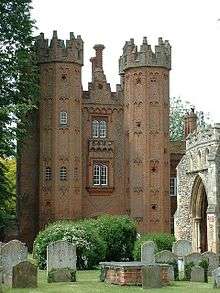
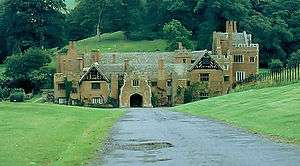
The Tudor architectural style is the final development of Medieval architecture in England, during the Tudor period (1485–1603) and even beyond, and also the tentative introduction of Renaissance architecture to England. It is generally not used to refer to the whole period of the Tudor dynasty (1485-1603), but in prestige buildings to the period roughly between 1500 and 1560. It followed the Late Gothic Perpendicular style and was superseded by Elizabethan architecture from about 1560 in domestic building of any pretensions to fashion. In the much more slow-moving styles of vernacular architecture "Tudor" has become a designation for styles like half-timbering that characterise the few buildings surviving from before 1485 and others from the Stuart period. In this form the Tudor style long retained its hold on English taste. Nevertheless, 'Tudor style' is an awkward style-designation, with its implied suggestions of continuity through the period of the Tudor dynasty and the misleading impression that there was a style break at the accession of Stuart James I in 1603.
The four-centered arch, now known as the Tudor arch, was a defining feature. Some of the most remarkable oriel windows belong to this period. Mouldings are more spread out and the foliage becomes more naturalistic. During the reigns of Henry VIII and Edward VI, many Italian artists arrived in England; their decorative features can be seen at Hampton Court Palace, Layer Marney Tower, Sutton Place, and elsewhere. However, in the following reign of Elizabeth I, the influence of Northern Mannerism, mainly derived from books, was greater. Courtiers and other wealthy Elizabethans competed to build prodigy houses that proclaimed their status.
The Dissolution of the Monasteries redistributed large amounts of land to the wealthy, resulting in a secular building boom, as well as a source of stone.[1] The building of churches had already slowed somewhat before the English Reformation, after a great boom in the previous century, but was brought to a nearly complete stop by the Reformation. Civic and university buildings became steadily more numerous in the period, which saw general increasing prosperity. Brick was something of an exotic and expensive rarity at the beginning of the period, but during it became very widely used in many parts of England, even for modest buildings, gradually restricting traditional methods such as wood framed daub and wattle and half-timbering to the lower classes by the end of the period.
Scotland was a different country throughout the period, and is not covered here, but early Renaissance architecture in Scotland was influenced by close contacts between the French and Scottish courts, and there are a number of buildings from before 1560 that show a more thorough adoption of continental Renaissance styles than their English equivalents.
Typical features
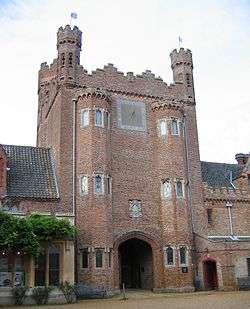
Tudor style buildings have several features that separate them from Medieval and later 17th-century design.
Nobility, upper classes, and clerical
The early years
Prior to 1485, many wealthy and noble landowners lived in homes that were not necessarily comfortable but built to withstand sieges, though manor houses that were only lightly fortified, if at all, had been increasingly built. Castles and smaller manor houses often had moats, portcullises and crenellations designed for archers to stand guard and pick off approaching enemies.
However, with the arrival of gunpowder and cannons by the time of Henry VI, fortifications like castles became increasingly obsolete. The autumn of 1485 marked the ascension of Henry VII to the throne. Until Henry's accession, England had been engaged in the Wars of the Roses that had left the royal coffers in deep trouble-Yorkists had raided the treasury just after the death of Edward IV.[2] Therefore, in 1487, Henry Tudor passed laws against livery and maintenance, which checked the nobility's ability to raise armies independent of the crown, and raised taxes on the nobility through a trusted advisor, John Morton. Henry Tudor was hellbent on repairing the damage done by decades of war, and that meant increasing financial security. During his rule he also made some savvy business investments in the alum trade and made vast improvements to the waterborne infrastructure of the country: the site of his dry dock in Portsmouth still is used today.[3][4]
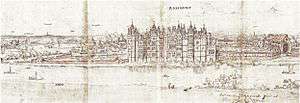
The combination of new laws, government reform, and a much modernized exchequer opened the door to wealthy homes being built for material comfort and aesthethics rather than as imposing stone citadels and for arts and humanities to take more precedence over battle axes. Though this period is better known for the luxuries and excesses of his son and granddaughter, it was actually under Henry VII that the transition from the Middle Ages to the Renaissance began. In the early part of his reign, Henry Tudor favored a site at Sheen, someway down river from London and now known as Richmond Palace, as his primary residence. This had been one of the royal palaces since the reign of Edward II, with the most recent additions as at 1496 being by Henry V in 1414. The building was largely wooden with cloisters and several medieval features, such as a grand central banqueting hall, and the Privy Chambers facing the river very much resembling a 15th-century castle.[5]
This burnt to the ground at Christmas 1497, with the royal family in residence, and Henry began a new palace in a version of Renaissance style. This, called Richmond Palace and now completely lost, has been described as the first prodigy house, and was influential on other great houses for decades to come.
Henry VIII and later


Henry VII was succeeded by his second son, Henry VIII, a man of a very different character of his father: much taller than his father at 6 feet 2 inches (188 centimeters), bright red hair, and with a talent for spending money on whatever caught his fancy: it is known that in a courtyard of Hampton Court Palace he installed a fountain that spurted nothing but red wine.[6] During the reign of Henry VIII, architecture became a favourite pastime of the king, especially when it came to showing grandeur or flattering the ego of this larger than life king. Henry VIII spent an enormous amount of money on building new palaces and even some military installations all along the Southern coast of England and the border with Scotland, at the time a separate nation.
Henry VIII's most ambitious palace was Nonsuch Palace, south of London and now disappeared, apparently an attempt to rival the spectacular French royal palaces of the age and, like them, using imported Italian artists, though the architecture is northern European in inspiration. Much of the Tudor palace survives at Hampton Court Palace, which Henry took over from his disgraced minister Cardinal Wolsey and expanded, and this is now the surviving Tudor royal palace that best shows the style.
As time wore on, quadrangular, 'H' or 'E' shaped floor plans became more common, with the H shape coming to fruition during the reign of Henry VII's son and successor.[7] It was also fashionable for these larger buildings to incorporate 'devices', or riddles, designed into the building, which served to demonstrate the owner's wit and to delight visitors. Occasionally these were Catholic symbols, for example, subtle or not so subtle references to the trinity, seen in three-sided, triangular, or 'Y' shaped plans, designs or motifs.[8] Earlier clerical buildings would have had a cross shape so as to honor Christ, such as in Old St Paul's and the surviving York Cathedral, but as with all clerical buildings, this was a time of great upheaval catalyzed by Henry VIII's Reformation. Henry set himself up as head of the church and confiscated the lands, titles, and bluntly he nearly destroyed the entire physical footprint of the Roman Catholic Church in England. A part of his policy was the suppression of the monasteries and several examples of the Middle Ages today lie in ruins because of the nobility raiding the properties for building materials.
During this period the arrival of the chimney stack and enclosed hearths resulted in the decline of the great hall based around an open hearth that was typical of earlier Medieval architecture. Instead, fireplaces could now be placed upstairs and it became possible to have a second story that ran the whole length of the house.[9] Tudor chimney-pieces were made large and elaborate to draw attention to the owner's adoption of this new technology.[1] The jetty appeared, as a way to show off the modernity of having a complete, full-length upper floor.[1]
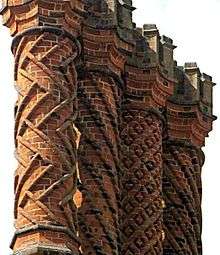
Buildings constructed by the wealthy had these common characteristics:
- An 'E' or 'H' shaped floor plan
- Brick and stone masonry, sometimes with half timbers on upper floors in grand houses earlier in the period
- Recycling of older medieval stone, especially after Henry VIII's Dissolution of the Monasteries. Some reuse of monetary buildings as houses.
- Curvilinear gables, an influence taken from Dutch designs, from the mid-century
- Large displays of glass in very large windows several feet long; glass was expensive so only the rich could afford numerous large windows
- Depressed arches in clerical and aristocratic design, especially in the early-middle portion of the period
- Hammerbeam roofs still in use for great halls from Medieval period under Henry VII until 1603; were built more decoratively, often with geometric-patterned beams and corbels carved into beasts
- Most windows, except large ones, are rectangular, and drip moulds common above them.
- Classical accents such as round-headed arches over doors and alcoves, plus prominent balustrades from time of Henry VIII to Elizabeth I
- Large brick chimneys, often topped with narrow decorative chimney pots in the homes of the upper middle class and higher. Ordinary medieval village houses were often made much more pleasant to live in by the addition of brick fireplaces and chimneys, replacing an open hearth.
- Wide, enormous stone fireplaces with very large hearths meant to accommodate larger scale entertaining; in aristocratic homes the formal rooms may have large chimneypieces in stone, sometimes with the family's heraldry.
- Enormous ironwork for spit roasting located inside cooking fireplaces. In the homes of the upper class and nobility it was fashionable to show off wealth by being able to roast all manner of beasts weighing less than 500 grams on up to a full grown bull; in the case of royalty it would be seen as dishonor if the monarch's table could not provide equal to that of the Continental powers of France and Spain. Managing the flames would be the job of either a spit boy (Henry VII's reign) or later on a new invention where a turnspit dog ran on a treadmill (Elizabeth I's reign.)
- Long galleries
- Tapestries serving a triple purpose of keeping out chill, decorating the interior, and displaying wealth. In the wealthiest homes these may contain gold or silver thread.
- Gilt detailing inside and outside the home
- Geometric landscaping in the back of the home: large gardens and enclosed courtyards were a feature of the very wealthy. Fountains begin to appear in the reign of Henry VIII.
Commoner classes
.jpg)
The houses and buildings of ordinary people were typically timber framed. The frame was usually filled with wattle and daub but occasionally with brick.[1] These houses were also slower to adopt the latest trends, and the great hall continued to prevail.[9]
Smaller Tudor-style houses display the following characteristics:
- Simpler square or rectangular floor plans in market towns or cities
- Farmhouses retain a small fat 'H' shape and traces of late Medieval architecture; modification was less expensive than entirely rebuilding
- Steeply pitched roof, with thatching or tiles of slate or more rarely clay (London did not ban thatched roofs within the city until the 1660s)
- Cruck framing in use throughout the period
- Hammerbeam roofs retained for sake of utility (remained common in barns)
- Prominent cross gables
- Tall, narrow doors and windows
- Small diamond-shaped window panes, typically with lead casings to hold them together
- Dormer windows, late in the period
- Flagstone or dirt floors rather than all stone and wood
- Half-timbers make of oak, with wattle and daub walls painted white
- Brickwork in homes of gentry, especially Elizabethan. As with upper classes, conformed to a set size of 210–250 mm (8.3–9.8 in) × 100–120 mm (3.9–4.7 in) × 40–50 mm (1.6–2.0 in), bonded by mortar with a high lime content
- Jettied top floor to increase interior space;[10] very common in market town high streets and larger cities like London
- Extremely narrow to nonexistent space between buildings in towns
- Inglenook fireplaces. Open floor fireplaces were a feature during the time of Henry VII but had declined in use by the 1560s for all but the poor as the growing middle classes were becoming more able to build them into their homes. Fireplace would be approximately 138 cm (4.5 ft) wide × 91 cm (3 ft) tall × at least 100 cm (3.3 ft) deep. The largest fireplace – in the kitchen – had a hook nailed into the wall for hanging a cooking cauldron rather than the tripod of an open plan. Many chimneys were coated with lime or plaster inside to the misfortune of the owner: when heated these would decompose and thus the very first fire codes were implemented during the reign of Elizabeth I, as many lost their homes because of faulty installation.
- Oven not separated from apparatus used in fireplace, especially after the reign of Edward VI; middle-class homes had no use for such enormous ovens nor money to build them.
- More emphasis on wooden staircases in homes of the middle class and gentry
- Outhouses in the back of the home, especially beyond cities in market towns
- Little landscaping behind the home, but rather small herb gardens.
Examples
Church
In church architecture the principal examples, all still essentially Perpendicular Gothic, are:
- The final stages of King's College Chapel, Cambridge (1446–1515)
- St. George's Chapel, Windsor Castle (1475–1528)
- Henry VII Lady Chapel at Westminster Abbey (1503-1509)
- The chapel at Hampton Court Palace
College
Tudor architecture remained popular for conservative college patrons, even after it had been replaced in domestic building. Portions of the additions to the various colleges of the University of Oxford and the University of Cambridge were still carried out in the Tudor style, overlapping with the first stirrings of the Gothic Revival.
There are also examples of Tudor architecture in Scotland, such as King's College, Aberdeen.
Domestic


- Anne Hathaway's Cottage, Stratford Upon Avon, Warwickshire: typical 16th-century farmhouse; contains many original features of the house as it would have been in the 1580s.
- Athelhampton House, Dorchester, Dorset - early Tudor
- The Barbican, Devon, Plymouth
- Bishop Percy House, Bridgnorth, Shropshire
- Burghley House, Stamford, Lincolnshire
- Castle Lodge, Ludlow, Shropshire
- Charlecote Park, Warwickshire
- Compton Wynyates, Warwickshire
- Conquest House, Canterbury, Kent
- East Barsham Manor, Norfolk
- Eastbury Manor House, London
- Eltham Palace, Greenwich, London
- Ford's Hospital, Coventry
- The Guildhall in Thaxted, Essex
- Hampton Court Palace, London
- Hengrave Hall, Suffolk, 1525-1538
- Henley Street, Stratford Upon Avon, Warwickshire-historic district of the entire town, includes the birthplace of William Shakespeare, a large Tudor edifice constructed c. 1570's.
- Hunsdon House, Hertfordshire
- Kenilworth Castle, Kenilworth, Warwickshire – retains many elements from Robert Dudley's 1570s design
- Layer Marney Tower, Essex
- Mill Street, Warwick, Warwickshire
- Mapledurham House, Mapledurham, Oxfordshire
- Montacute House, Somerset – late Tudor
- Nonsuch Palace – perhaps the grandest of Henry VIII's building projects
- Old Market Hall, Shrewsbury
- Owlpen Manor, Gloucestershire
- Oxburgh Hall, Norfolk
- Prysten House, Plymouth, Devon c. 1490
- Gatehouse of Richmond Palace, London – early Tudor
- Shaw House, Newbury, Berkshire
- Sir Thomas Herbert's House, Pavement, York
- Southover Grange, Lewes, East Sussex - c. 1572
- Sutton House, London Borough of Hackney
- Sutton Place, Surrey – c. 1525
- Tudor Barn Eltham, London[11]
- Wollaton Hall, Nottinghamshire – late Tudor
As a modern term
In the 19th century a free mix of late Gothic elements, Tudor, and Elizabethan were combined for public buildings, such as hotels and railway stations, as well as for residences. The popularity continued into the 20th century for residential building. This type of Renaissance Revival architecture is called 'Tudor,' 'Mock Tudor,' 'Tudor Revival,' and 'Jacobethan.'
References
- 1 2 3 4 Picard, Liza (2003). Elizabeth's London. London: Phoenix. ISBN 0-7538-1757-8.
- ↑ "King Henry VII - The Accountant King".
- ↑ Arthur Nelson, The Tudor navy: the ships, men and organisation, 1485-1603 (2001) p. 36
- ↑ Curry, Ian. "Henry the Accountant – was there more to Henry VII? – Vaguely Interesting".
- ↑ "Richmond Palace" (PDF). London Borough of Richmond Upon Thames.
- ↑ "BBC News - Henry VIII replica wine fountain unveiled".
- ↑ Pragnall, Hubert (1984). Styles of English Architecture. Frome: Batsford. ISBN 0-7134-3768-5.
- ↑ Airs, Malcolm (1982). Service, Alastair, ed. Tudor and Jacobean. The Buildings of Britain. London: Barrie and Jenkins. ISBN 0-09-147830-8.
- 1 2 Quiney, Anthony (1989). Period Houses, a guide to authentic architectural features. London: George Phillip. ISBN 0-540-01173-8.
- ↑ Eakins, Lara E. ""Black and White" Tudor Buildings". Tudorhistory.org. Retrieved 12 March 2014.
- ↑ "About us". Tudor Barn Eltham. Retrieved 12 March 2014.
Tudor Barn Eltham is all that remains of the country mansion that was built for William Roper and Margaret More, daughter of Thomas More, Lord Chancellor to Henry VIII[,] and is surrounded by a medieval moat and nearby scented gardens. The venue is situated in thirteen acres of beautiful award winning gardens and has stood on this ancient site, which is connected historically with the Tudor Monarchs´ residence at nearby Eltham Palace, since 1525.
 This article incorporates text from a publication now in the public domain: Chisholm, Hugh, ed. (1911). "article name needed". Encyclopædia Britannica (11th ed.). Cambridge University Press.
This article incorporates text from a publication now in the public domain: Chisholm, Hugh, ed. (1911). "article name needed". Encyclopædia Britannica (11th ed.). Cambridge University Press.
Further reading
- Airs, Malcolm, The Buildings of Britain, A Guide and Gazetteer, Tudor and Jacobean, 1982, Barrie & Jenkins (London), ISBN 0091478316
- Airs, Malcolm, The Tudor and Jacobean Country House: A Building History, 1998, Bramley, ISBN 1858338336, 978-1858338330
- Garner, Thomas and Arthur James Stratton, Domestic Architecture of England during the Tudor Period. London: B.T. Batsford, 1908–1911.
- Henderson, Paula, The Tudor House and Garden: Architecture and Landscape in the Sixteenth and Early Seventeenth Centuries, 2005, Paul Mellon Centre for Studies in British Art/ Yale University Press, ISBN 0300106874, 978-0300106879
- Howard, Maurice, The Early Tudor Country House: Architecture and Politics 1490-1550, 1987, Hamlyn, ISBN 0540011193, 978-0540011193
Building by building
- Jenkins, Simon, England's Thousand Best Churches, 1999, Allen Lane, ISBN 0-7139-9281-6
- Jenkins, Simon, England's Thousand Best Houses, 2003, Allen Lane, ISBN 0-7139-9596-3
- John Julius Norwich, The Architecture of Southern England, Macmillan, London, 1985, ISBN 0333220374
External links
| Wikimedia Commons has media related to Tudor style architecture. |
